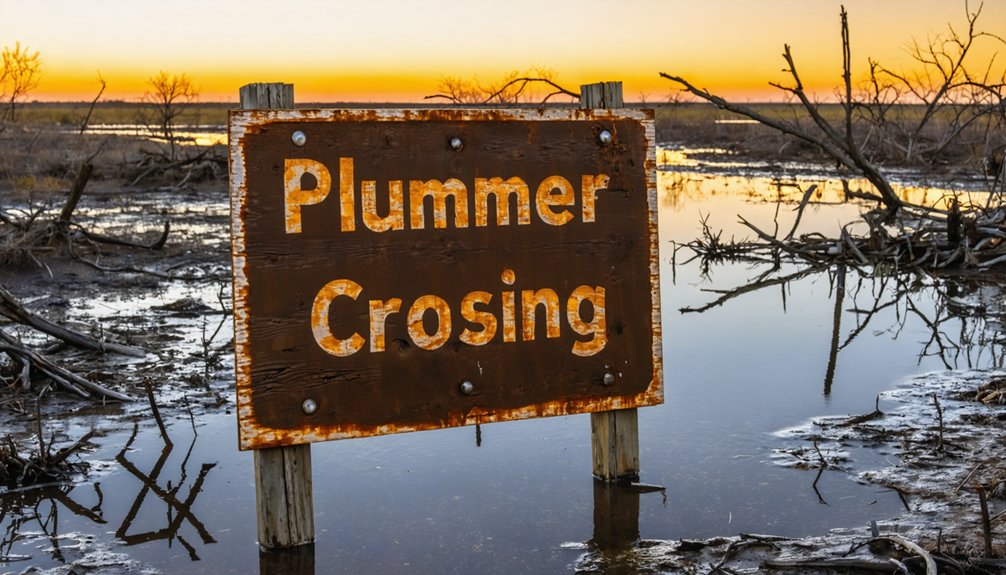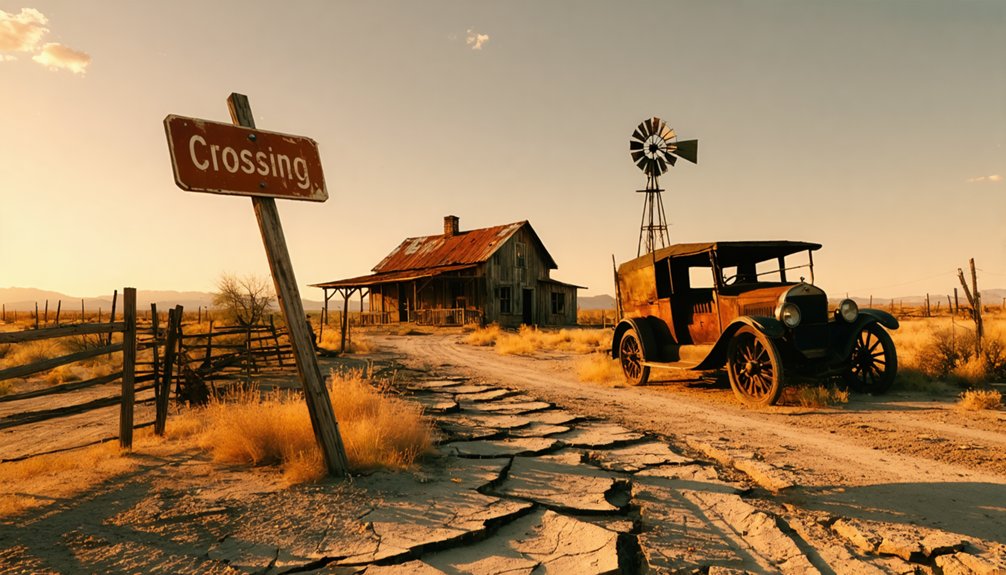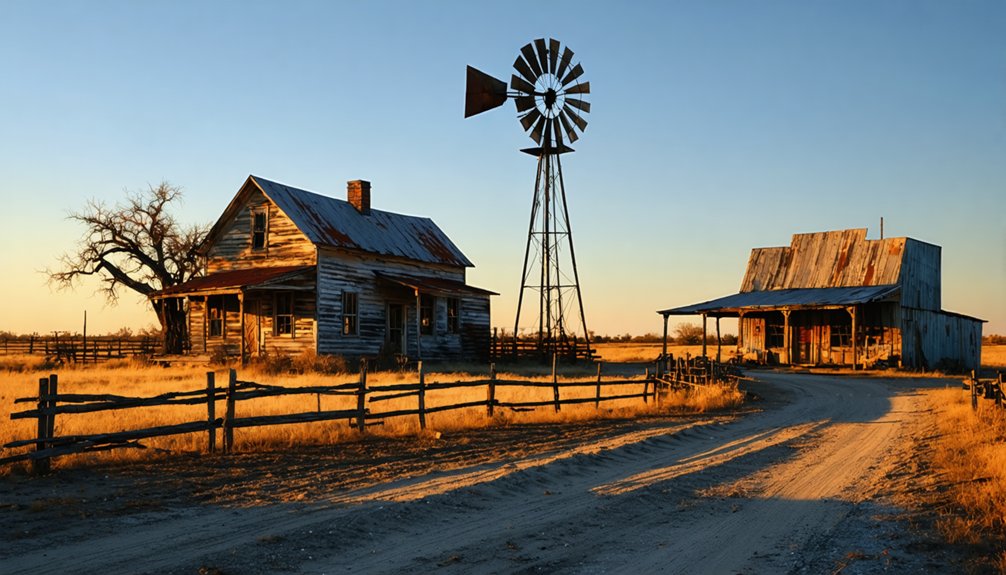You’ll find Plummer Crossing‘s remains along Texas’s Canadian River, where Luther Plummer’s horse discovered a safe river passage in 1833. The settlement grew into an essential hub along the Jones & Plummer Trail, handling 150,000 pounds of weekly freight between 1880-1886. As a critical lifeline for buffalo hunters and settlers, the town thrived until railroads arrived in 1888. The ghost town‘s weathered structures still whisper tales of frontier determination and survival.
Key Takeaways
- Plummer Crossing emerged as a vital trading hub along the Jones and Plummer Trail, facilitating massive freight operations of 150,000 pounds weekly.
- The settlement originated from Luther Plummer’s discovery of a safe river crossing in 1833 at the Navasota River.
- The town thrived between 1880-1886 as a crucial stopover for buffalo hunters, soldiers, and settlers traversing the Texas frontier.
- Quicksand hazards at the Canadian River made Plummer Crossing’s safe passage essential for regional commerce and transportation.
- The ghost town’s decline began in 1888 when railroad development made the old wagon routes obsolete.
A Horse’s Gift: The Discovery of Safe Passage
While the Texas frontier of the 1870s posed deadly risks from bandits and hostile encounters, the Jones & Plummer Trail emerged as an unexpectedly secure route through the untamed Panhandle.
You’ll find that Ed Jones and Joe Plummer, former buffalo hunters turned merchants, pioneered one of the most reliable horseback routes between Dodge City and the Texas settlements. Their strategic path followed natural landmarks, keeping you away from the era’s most dangerous conflict zones while ensuring access to water and grazing lands. The trail’s frequent water hole locations made it particularly appealing for travelers crossing the harsh terrain. The path became vital for transporting buffalo hides from Lipscomb County to markets in Kansas.
Unlike other survival strategies of the time, this trail proved remarkably safe – so much that by 1878, you’d see Charles Rath moving 150,000 pounds of freight weekly to Mobeetie.
The Jones & Plummer Trail’s safety enabled massive freight operations, with Rath’s wagons hauling 150,000 pounds weekly to frontier settlements.
The trail’s security attracted stagecoaches, mail services, and cattle drives, transforming it into a lifeline for regional development.
Birth of a River Settlement
You’ll find the settlement’s origins at the spot where Luther Plummer’s horse first discovered the safe river crossing in 1833, as the Parker and Plummer families searched for an ideal homestead after leaving Arkansas.
The crossing point’s strategic position at the headwaters of the Navasota River offered settlers reliable fresh water, fertile soil, and natural defenses that would later support Fort Parker’s construction. This location proved vital for the settlement’s defense when they built a 12-foot high wall to protect their families. During its peak years, the site was crucial for pioneers transporting 100,000 pounds of freight weekly along established trade routes.
Your journey back in time reveals how this horse-led discovery shaped the community’s future, as the families first camped along the Angelina, Colorado, and Brazos rivers before finally establishing their permanent settlement at Plummer’s Crossing that fall.
Safe Passage Becomes Settlement
As settlers pushed into Texas during the 1830s, the Plummer family joined other members of the Parker clan to establish Fort Parker near the headwaters of the Navasota River in 1834. Their settlement strategies centered on building a fortified compound with 12-foot log walls and strategic blockhouses, while negotiating treaties with local Indian leaders.
You’d have found the river crossing at Fort Parker perfectly situated for both defense and accessibility. As traffic increased along the waterways, trading posts and road ranches emerged to serve buffalo hunters, cattle drivers, and pioneers. The establishment of the trail by Jones and Joe Plummer in the 1870s brought even more travelers through the area. The trail became a vital supply route, with five towns established along its length to support growing commerce.
What began as a safe passage point transformed into a thriving community, with families building cabins both inside and outside the fort’s protective walls. The settlement’s position along established trails facilitated its growth as a crucial stop for travelers and traders.
Horse-Led River Crossings
Since buffalo hunters and freight wagons required safe passage across treacherous waters, the Jones and Plummer Trail’s river crossings became essential lifelines for regional commerce in 1874.
You’d find experienced horsemen leading the way through fords, testing river navigation points for quicksand and dangerous terrain before wagons attempted passage. Your success at these crossings depended heavily on equine strength, as horses proved invaluable in pulling loaded wagons through challenging water levels.
During peak times, you’d witness over 100,000 pounds of freight moving through these crossings weekly. While Native American raids and severe weather posed constant threats, the economic promise of successful river passage kept traders pushing forward. Charles Rath’s freighters transported an impressive 150,000 pounds of cargo weekly to supply the growing settlement of Mobeetie.
Your chances improved at locations where wooden toll bridges eventually replaced the most hazardous fords, though many still preferred traditional water crossings to avoid fees.
Life Along the Canadian River’s Edge
Life along the Canadian River’s edge presented unique challenges and opportunities for those who made their home near its banks.
You’d find settlers maneuvering the region’s unpredictable river ecology, from flash floods during derechos to stretches of quicksand that could trap the unwary. Settlement patterns followed the water’s course, with communities establishing themselves where the terrain allowed for agriculture and livestock grazing. Early ranchers transformed the area after buffalo herds were eliminated in the late 1800s.
Settlers braved treacherous quicksand and sudden floods, building communities where the Canadian River’s banks allowed crops to flourish.
You’d witness a diverse tapestry of life, from Native American tribes like the Comanche and Kiowa to European traders establishing routes through the territory. Many of these routes were first mapped by French explorer Harpe in 1719.
The river’s edge supported wild turkey and pronghorn, while its valley exposed striking red beds and dolomite formations.
Despite the challenges of building near its gorges, the Canadian River provided essential resources for those bold enough to stake their claim along its shores.
The Jones and Plummer Trail Connection
The Jones and Plummer Trail emerged in 1874 when buffalo hunters Charles “Dirty Face” Jones and Joe H. Plummer blazed an essential merchant route connecting Dodge City, Kansas to Mobeetie, Texas.
You’ll find the trail’s significance reflected in its strategic 168-mile path through the Oklahoma and Texas Panhandles, where it served as a lifeline for settlers, traders, and cattlemen. Their cottonwood picket post at Wolf Creek became a vital trading hub for buffalo hunters in the region.
The trail’s impact on regional commerce can’t be overstated. It supported Fort Elliott’s construction, facilitated trade with Arapahoe and Cheyenne tribes, and transported critical supplies to frontier settlements.
Unlike other routes, you’d encounter more frequent watering holes along this path, though you’d still face challenging terrain with deep ruts and shifting sand.
The trail’s economic importance lasted until 1887, when railroad expansion gradually diminished its role in frontier commerce.
Tales of Quicksand and Survival

Amid the treacherous stretches of the Jones and Plummer Trail, quicksand posed a lethal threat to travelers crossing the Canadian, Cimarron, and Beaver Rivers.
You’d discover these deadly hazards could span up to 400 yards after flooding, swallowing wagons and horses without warning.
To survive these quicksand dangers, you’d need to rely on local expertise like Barney Plemons, whose remarkable horse could detect safe crossing points.
Seasoned guides like Barney Plemons and their trustworthy mounts proved invaluable for navigating treacherous quicksand crossings along frontier trails.
You’d learn that strategic river bends offered safer passages, while sudden floods could transform familiar crossings into death traps.
Experienced traders spaced their water stops carefully, watching for environmental signs that might reveal hidden quicksand.
If you’d been hauling freight or moving your family west, your survival tactics would’ve centered on gathering local knowledge and reading the terrain’s subtle warnings.
The Rise and Fall of a Frontier Town
You’ll find the origins of Plummer Crossing inextricably linked to the deadly quicksand threats of the Canadian River, where Barney Plummer’s discovery of a safe passage proved life-saving for countless travelers.
The settlement quickly grew into a crucial transportation hub along the Jones and Plummer Trail, serving as a lifeline for buffalo hunters, soldiers, and settlers moving between Dodge City and the Texas Panhandle.
Quicksand’s Deadly River Legacy
Lurking beneath the seemingly placid waters of the Canadian River, deadly quicksand transformed Plummer Crossing into both a vital lifeline and lethal hazard for frontier travelers.
You’d never know by looking at the surface where these deceptive deathtraps lay waiting, ready to swallow wagons, livestock, and pioneers without warning. The quicksand dangers made river navigation a high-stakes gamble, where one wrong step could mean disappearing without a trace.
Consider these harsh realities of Plummer Crossing’s quicksand legacy:
- Barney Plemons’ legendary horse could detect safe crossing spots, becoming essential for survival.
- Local settlers turned the hazard into profit by offering guided crossing services.
- Countless travelers and livestock were lost to the river’s treacherous depths.
- The quicksand’s reputation shaped regional trade routes and settlement patterns.
Transportation Hub’s Brief Glory
When buffalo hunters Ed Jones and Joe Plummer blazed their 168-mile trail in 1874, they unknowingly laid the foundation for a significant transportation corridor that would transform the Texas Panhandle.
You’d have witnessed a remarkable economic transformation at Plummer Crossing during its peak years of 1880-1886. The town emerged as an essential hub along the trail, where Charles Rath’s freight wagons hauled an astounding 150,000 pounds of goods weekly to Mobeetie.
The transportation evolution continued as P.G. Reynolds established stagecoach service in 1886, connecting Dodge City to the Texas frontier. Mail contractors, troops, and cattle drives all converged here, making the crossing a lifeline for regional commerce.
But the town’s glory proved short-lived – when the railroads arrived in 1888, they quickly rendered the old wagon routes obsolete.
Legends and Lore of the Crossing

The legendary tale of Plemons Crossing began with a remarkable horse and its owner, Barney Plemons, who discovered the safest passage across the treacherous Canadian River in the Texas Panhandle.
This crucial crossing point, where Plemons folklore tells of an extraordinary equine ability to detect deadly quicksand bogs, soon transformed into a bustling settlement.
You’ll find the essence of frontier survival woven into these local stories:
- The horse’s supernatural sense for avoiding invisible quicksand saved countless lives
- Travelers depended on this safe route when other river crossings meant certain death
- The settlement’s growth from crossing point to county seat reflects pioneer determination
- Local ghostly apparitions and unexplained sounds echo the hardships of frontier life
This proof of frontier ingenuity lives on in regional storytelling, preserving the spirit of Texas survival.
A Ghost Town’s Legacy in Texas History
Situated along the historic Jones and Plummer Trail, Plummer Crossing emerged as an essential hub that shaped Texas Panhandle commerce in the late 1800s.
Located at a vital crossroads, Plummer Crossing became a cornerstone of trade and commerce in the Texas Panhandle’s frontier days.
You’ll find this ghost town’s historical significance deeply woven into Texas frontier life, from its beginnings as Barney Plemons’ strategic river crossing to its role as Hutchinson County’s seat.
The settlement’s legacy reflects the dramatic transformation of the Texas frontier, where buffalo hunters turned merchants established critical trade routes.
You can trace the town’s evolution through changing economies – from the bustling days of freight and cattle drives to the challenges that came with railroad expansion.
While Plummer Crossing couldn’t survive the shifting tides of progress, it stands as a reflection of the adaptability and resilience of Texas frontier communities.
Frequently Asked Questions
What Were the Typical Costs Charged for Guiding Travelers Across the River?
You’ll find river tolls varied from 25 cents for horsemen to 50 cents for a single team, while crossing fees for six-horse teams reached one dollar at the Arkansas River.
How Many Documented Deaths Occurred Due to Quicksand at Plummer Crossing?
Clear as day, you won’t find any documented deaths from quicksand hazards at Plummer Crossing. While historical accounts mention quicksand’s presence, there’s no official record of fatalities at this location.
Did Native American Tribes Use This Crossing Point Before European Settlement?
You’ll find Native tribes, particularly Comanche and Kiowa, actively used this crossing point for buffalo hunting and trade routes. Archaeological evidence and tribal histories confirm its cultural significance before European settlement.
What Happened to Barney Plemons’s Descendants After the Town’s Decline?
Like leaves scattered by prairie winds, you’ll find the Plemons legacy dispersed throughout Texas and neighboring states, with family stories suggesting descendants moved to larger cities for better opportunities after 1952.
Were There Any Significant Archaeological Finds Discovered at the Former Settlement?
You won’t find documented archaeological significance at this site yet, though typical historical artifacts from Texas ghost towns – like household items and building foundations – likely remain unexplored beneath the soil.
References
- https://mix941kmxj.com/the-strange-sad-story-of-a-texas-ghost-town-youll-never-visit/
- https://www.youtube.com/watch?v=ezvJ8HPRoq4
- https://www.legendsofamerica.com/jones-plummer-trail/
- https://www.youtube.com/watch?v=j1vcl01ulo8
- https://www.visitoldmeadecounty.com/jasper-/newpage1d9eb5c8
- https://www.tshaonline.org/handbook/entries/jones-and-plummer-trail
- https://en.wikipedia.org/wiki/List_of_ghost_towns_in_Texas
- https://cedarbayoumarina.com/four-ghost-towns-under-lake-texoma/
- https://www.tshaonline.org/handbook/entries/plummer-joseph-h
- https://www.hmdb.org/m.asp?m=93525



